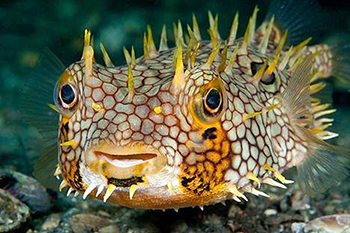The Striped Burrfish
Chilomycterus Schoepfii
Other Names: Spiny Boxfish, Spiny Puffers

Taxonomy
Kingdom: Anamalia
Phylum: Chordata
Class: Actinopterygii
Order: Tetraodontiformes
Family: Diodontidae
Life History/ Ecology
The Striped Burrfish is commonly found in sea grass beds in sheltered, coastal waters as well as on coastal reefs. The Burrfish usually Is considered to be carnivorous but does occasionally graze on algae with teeth that are fused to form a beak-like crushing structure. It has massive spines for its size and possesses the extraordinary capability of instantaneous inflations to fend off predators. It can inflate its body by taking in either air or water into a ventral extension of the stomach. The size of the fish is considered to be small to medium size and usually ranges from 20 to 30 centimeters in length. The coloration of the fish adds to its unique appearance that shows off a mixture of brown and pale yellow with several black spots on its sides.
Habitat
Adults tend to stay within 30 feet or so of the surface but have been found in water depths of up to 90 meters. The waters of the tropical Atlantic Ocean and the Caribbean house most of the Spiny Boxfish population but they can also be found as far north as Nova Scotia all the way down south as far as Belize.
Food
Primary foods include shellfish, crustaceans and hard shelled foods such as snails. The Burrfish is far from picky and will consume basically anything it can crush or fit in its mouth. Other food sources include larval eels, jellyfish, and as was stated earlier, they will also eat algae but cannot thrive on it. Because of the Spiny puffers’ strong bite, they are able to feed on mollusks that other fish their size cannot. Feeding studies have found entire hermit crab shells inside of their stomachs along with crushed shells, which show just how powerful their bite really can be.
Conservation Actions
There are no species- specific conservation measures in place for the Striped Burrfish. However, many protected marine areas coincide with the fishes’ natural habitat.
Spawning
They are believed to spawn offshore but uncertainty exists as to the exact time of year, yet some researchers list the spawning season during July.
Major Threats
Striped Burrfish are harvested for the international aquarium trade, but there is no indication that suggests it is causing a dramatic decline in their numbers, however, habitat loss seems to be the biggest factor in the decline in their numbers in some areas. Also since these fish are associated with coastal habitats and sea grass beds, threats from increasing sea temperatures, coastal development, and pollution from land sedimentation, as well as destructive fishing practices seem to be the main culprits of their population decline.
References
Please note that the following references may have either been removed or relocated by the webpage owners since the time this student report was created.
1. Perlmutter, Alfred, 1961. Guide to Marine Fishes, p. 411.
2. Martin, F.D. and G.E. Drewry, 1978. in Development of the Fishes of the Mid-Atlantic Bight. Vol. 5: 306-309.
3. Motta, Philip J., Kari B. Clifton, Patricia Hernandez, Bradley T. Eggold, Steven D. Giordano and Rebecca Wilcox; 1995. Feeding Relationships among nine species of seagrass fishes of Tampa Bay, Florida. Bulletin on Marine Science 56(1); 185 - 200.
4. Kuhlman, Mark L., 1992. Behavioral avoidance of predation in an intertidal hermit crab. Journal of Marine Biology and Ecology 157: 143 - 158.
Matsuura, K. 2010. Chilomycterus schoepfii. In: IUCN 2011. IUCN Red List of Threatened Species. Version 2011.2. <www.iucnredlist.org>. Downloaded on 31 May 2012.
Pictures
Please note that the following references for pictures may have either been removed or relocated by the webpage owners since the time this student report was created.
http://www.united-academics.org/magazine/7760/pic-of-the-day-the-smiling-web-burrfish/
http://www.tflats.com/belize-diving/diving-main